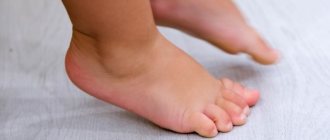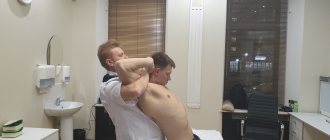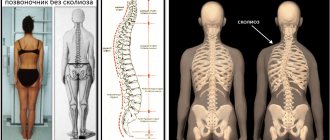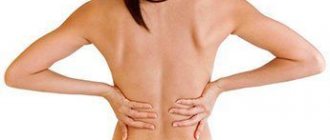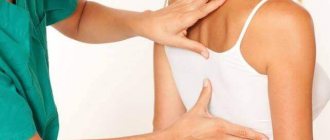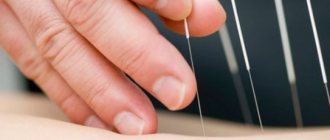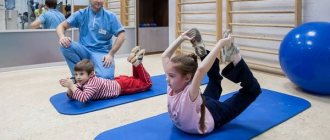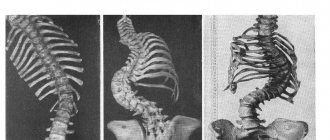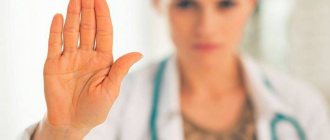August 29, 2019
7629
0
3 out of 5
A disease known to everyone since childhood, scoliosis is diagnosed more and more often every year. According to statistics, approximately every sixth person suffers to a greater or lesser extent from scoliotic spinal deformity.
If left untreated, it poses a serious threat to health and, in severe forms, can lead to disability. Modern medicine has many opportunities to eliminate this pathology of the musculoskeletal system and is able to restore the joy of movement to most patients.
The latest methods of conservative and surgical treatment of scoliosis in Moscow are now available to everyone at the SL Clinic. We have everything necessary to conduct a full diagnosis and treatment of spinal scoliosis in adults and children. You no longer need to waste time and travel throughout the capital in search of different specialists; doctors whose help is needed by patients with scoliosis are waiting for you at the “SL Clinic” at (address).
Scoliosis: what is it
Scoliosis is a steadily progressive lateral curvature of the axis of the spinal column, followed by twisting of the vertebrae and increased physiological curves. This is accompanied by a change in posture and body proportions. Patients have protrusion of the shoulder blades, asymmetry of the shoulders and skewed hip line. Without appropriate therapy, under the influence of physical activity, the deformation constantly intensifies, the chest is distorted, and in severe cases, the body becomes so distorted that the internal organs begin to suffer seriously.
The most dangerous periods for the occurrence of pathology are considered to be the stages of intensive growth of a child, occurring at 4–6 years and 10–14 years. It is at this age that stage 1 spinal scoliosis in children is most often diagnosed for the first time and treatment begins. Although there are often cases when pathology is first detected in adults.
The reasons for the development of the disease lie in:
- developmental anomalies;
- neuromuscular diseases, including SMA (spinal muscular atrophy, cerebral palsy, muscular dystrophy;
- metabolic disorders;
- suffering severe injuries;
- degenerative-dystrophic processes;
- different leg lengths.
Often the cause of scoliosis cannot be determined and treated. In such situations, an idiopathic form of the disease is diagnosed, and all efforts are directed toward eliminating the curvature of the spinal deformity.
Provoking factors
The disease is assessed taking into account the angle of curvature. The simplest is the first stage of the disease. This is where the deformation begins. Scoliosis of the first degree is considered to be an angle of no more than 10 degrees. Doctors identify the main possible factors that can lead to this pathology of spinal development:
Most often, scoliosis is diagnosed in adolescents, with the peak of the disease observed between the ages of 10 and 15 years. In girls, the disease occurs many times more often. Most likely due to fragility of bones and weakness of the muscular system. Most often, children experience idiopathic scoliosis of the first degree. There are suggestions that its development may be influenced by factors such as calcium deficiency, heredity, accelerated growth, and poor posture.
Types of scoliosis
Depending on the degree of curvature, scoliosis is distinguished:
- c-shaped – the most common form, which is characterized by the formation of 1 pathological bend;
- s-shaped – there are 2 arcs, the second of which is formed as a result of compensatory mechanisms;
- z-shaped - the heaviest variety, characterized by the presence of 3 bends, but this shape is very rare.
The disease is also classified according to the direction of the curvature into left-sided and right-sided scoliosis, and according to the location of the curvature into:
- cervicothoracic – rare, but can occur with serious changes in the functioning of the respiratory system and cardiovascular system;
- chest - often right-sided, accompanied by difficulty breathing, disruption of the heart and the formation of a rib hump, which leads to severe pain;
- lumbar – the most common form, usually occurs mildly and is accompanied by osteochondrosis and lower back pain;
Particular attention is paid to the treatment of stage 1 thoracic scoliosis, as it progresses faster than that of the lumbar region.
In most cases, first-degree scoliosis is diagnosed in childhood during routine medical examinations. Its formation produces:
- position of one shoulder higher than the other;
- difference in distance between arm and waist;
- asymmetrical position of the shoulder blades.
The condition of the spine is assessed when a person stands straight with his arms hanging freely along his body.
If symptoms of the disease are detected, it is very important to immediately carry out comprehensive treatment for grade 1 scoliosis in children. Otherwise, the rapid growth of the body will lead to a rapid worsening of the deformation and disruption of the functioning of the heart and respiratory organs. It is also possible that radicular syndrome and compression of the spinal cord may occur, which is associated with severe pain. Treatment of scoliosis in children and adolescents in Moscow is successfully carried out at the SL Clinic.
Types of spinal curvature
Scoliosis is divided into four types based on the degree of curvature. Such an assessment system was invented in the mid-twentieth century by V.D. Chaklin.
- The first degree is easily corrected by training. The angle of inclination of the spine ranges from five to ten degrees.
- The second stage is treated successfully, but in the absence of proper training it quickly moves into the third stage. Tilt angle up to twenty-five degrees.
- The third degree is difficult to correct. Angle up to fifty degrees.
- The fourth degree is an extremely advanced stage of scoliosis. Characterized by an angle of fifty degrees and above.
Lack of treatment leads to pathological changes in the skeleton of the sternum and ribs, scoliotic disease develops.
This worsening of the situation leads to displacement of internal organs: the heart muscle, vascular bundle and lungs.
Scoliosis degrees
According to the international classification, there are 4 degrees of deformation:
- The angle of curvature does not exceed 10°. There is a slight stoop, signs of asymmetry in the waist and shoulder level. The patient involuntarily keeps his head down. An x-ray reveals a tendency to rotate the vertebrae.
- The curvature reaches 11–25°. When changing body position, the curvature of the spine does not disappear. With right-sided scoliosis of the 2nd degree, there is a prolapse of the right half of the pelvis, distortion of the waist triangle and the outline of the neck. A protrusion forms on the right side in the chest area, and a muscle roll forms in the lumbar region. When curving to the left side, the changes are mirror-like in nature. X-rays show twisting of the vertebrae.
- The angle of curvature is in the range of 26–50°. To the above signs is added protrusion of the anterior costal arches and the acquisition of clear outlines of the costal hump. At the same time, the tone of the abdominal muscles decreases.
- The angle exceeds 50°. The body is severely deformed. All of the above symptoms are intensified many times over.
Conservative therapy
Treatment of childhood scoliosis of 1st and 2nd degrees is the task of an orthopedist. It is this specialist who can easily recognize the first symptoms of deformity development and select the optimal tactics for correcting it.
Treatment of spinal scoliosis in school-age children of grade 1 and 2 is carried out through conservative therapy. It involves a whole range of measures:
- drug therapy;
- exercise therapy;
- wearing an orthopedic corset;
- physiotherapy;
- massage;
- treatment by an osteopath.
In adults, treatment of grade 1 spinal scoliosis consists mainly of taking measures to prevent its worsening and regular examinations. Hard work, active sports and a number of other factors can provoke the progression of the disease. It is important not to miss this moment and take timely measures and start therapy. But it must be taken into account that conservative treatment of left-sided or right-sided thoracic scoliosis of the spine in adults, as well as deformities of other parts, is effective only until the end of the formation of the skeleton. In the future, it is possible to eliminate the symptoms of the disease without surgery only if it is caused by pathologies of the intervertebral discs.
All scoliosis treatment methods are available to you in our clinic. Qualified doctors will select the optimal types of treatment that will give the most pronounced results and eliminate spinal curvature.
Drug therapy
Treatment of grade 2 scoliosis of the lumbar and thoracic spine rarely requires the use of painkillers. However, if discomfort occurs, you can take NSAIDs.
The main direction of therapy is strengthening bone tissue. For this purpose, vitamins B and D are prescribed, as well as calcium supplements. The dosage is selected strictly individually.
Physiotherapy
Exercise therapy is the basis of conservative treatment of grade 2 scoliosis in adolescents and adults. Classes, especially in the initial stages of therapy, are conducted under the guidance of a specialist. He can correctly calculate the load and select the optimal set of exercises, based on whether C-shaped or s-shaped scoliosis of the 2nd degree is being treated.
Recommended exercises include the following:
- Stand on your toes and stretch your arms up, smoothly spreading them to the sides. During the following repetitions, simultaneously with stretching the spine, turn the body to the left and right.
- Lying on your back, bend your knees and pull them towards your stomach, pressing your back tightly to the floor.
- Standing on your knees and placing your hands on the floor, while inhaling, bend your lower back and raise your head up, but as you exhale, lower your head and bend your back.
- Remaining in the same starting position, while inhaling, extend the right arm and leg. Return to starting position. Repeat, changing arms and legs. During the exercise you need to breathe evenly.
- Sit cross-legged. Place your hands on one of your shoulders. As you inhale, turn your body toward your arms, and as you exhale, they return back. Change the position of your hands and repeat again.
It is especially important to do therapeutic exercises while wearing a corset, since it provokes a decrease in muscle tone. Otherwise, there is a high probability of relapse of the disease.
Yoga and swimming are very useful for patients of any age. Regular visits to the pool twice a week helps strengthen muscles and rotate the vertebrae into a normal position.
It is possible to treat scoliosis in children according to Bubnovsky. The method involves the targeted impact of moderate physical activity with the almost complete elimination of gravitational forces. Regular exercise on a specially designed exercise machine helps strengthen muscles and give the spinal column the correct position.
Corset
Treatment of lumbar scoliosis of 1st and 2nd degree in adolescents and young children is carried out using a special orthopedic corset. It promotes the formation of the correct position of the spine and the alignment of the vertebrae.
There are different models of corsets:
- Chenault;
- Milwaukee;
- Lyonsky;
- Boston Hard;
- Chest Belt.
The choice of a specific one is made by the doctor. You should be in the orthosis from 16 to 23 hours a day for a long time. This requires endurance and patience on the part of both the patient and his loved ones. You can stop wearing a corset only after the period of active growth has ended.
Physiotherapy
Treatment of adolescent scoliosis and especially the cervical spine in adults, combined with osteochondrosis, is very well complemented by physiotherapy sessions. They activate blood flow, which saturates the tissues with useful substances and strengthens the back muscles.
The most effective appointment is considered to be:
- ultrasound therapy;
- magnetic therapy;
- electrophoresis;
- electromyostimulation;
- hydromassage;
- salt baths;
- thermal procedures.
Manual therapy
A properly performed massage can strengthen the back muscles, saturate the tissues with oxygen and nutrients, and reduce pressure on the spine. Thanks to a course of manual therapy, posture improves, discomfort is eliminated, and displaced vertebrae gradually return to their correct position.
But you should be careful when choosing a specialist. Osteopaths without medical education may not only fail to achieve good results, but also significantly worsen the situation. Therefore, you can trust massage only to qualified specialists.
Exercise therapy exercises and techniques for scoliosis in a child
Therapeutic physical training for scoliosis includes a set of measures aimed at eliminating the disease. It includes massage, physiotherapy, manual therapy, therapeutic showers, gymnastics, swimming and yoga.
Only a professional doctor creates such a complex and selects exercises. Exercises are especially effective in the early stages of scoliosis.
Technique for performing exercises for scoliosis:
- The optimal number of repetitions of each exercise is 10 or 15 times. If pain occurs, this figure is halved.
- Severe back pain when doing exercises indicates that it is better to stop the exercise. Consultation with a physician is required.
- Leg training should be followed by shoulder training.
- The load on the spine increases gradually.
- You cannot stretch your back and perform rotational movements at the same time.
Stretching the spine without support under your feet is prohibited
Prevention of disease progression
Treatment of scoliosis in children and adults will be ineffective if patients lift heavy objects, engage in strenuous sports, and sit incorrectly. It is recommended to sleep on a flat, fairly hard mattress, and daily long walks should become an integral part of life.
It is important to eat a balanced diet so that the body does not experience a deficiency of the substances it needs. This will ensure the correct development of bone tissue and its sufficient strength, which will serve to prevent the development of other diseases of the musculoskeletal system.
Surgery
Surgery for scoliosis is indicated for approximately 10% of all patients. It is carried out when:
- severe pain and limitation of mobility that cannot be eliminated through conservative therapy;
- deformities with a curvature angle of more than 40–45° (if it exceeds 50–60°, surgical intervention is required, especially in children during the period of active growth);
- congenital anomalies that provoked the development of the disease - synostosis, the presence of additional hemivertebrae;
- the occurrence of cardiac or respiratory failure;
- threat of damage to the spinal cord, its blood vessels and nerves.
Thus, surgery to correct scoliosis is mainly performed at stages 3 or 4 of its development. It is also necessary to eliminate congenital anomalies. In other cases, our doctors are able to conservatively treat the symptoms of spinal scoliosis and obtain excellent results.
For congenital defects that provoke rapid progression of the disease, surgery is recommended for grade 2 scoliosis in children. This is a preventative measure. Treatment of the cause of scoliosis in children eliminates the prerequisites for repeated curvature of the spine. As a result, it is possible to avoid disruption of the functioning of internal organs and reduce the likelihood of developing other complications.
Types and features of operations
All types of surgical treatment of the disease used today involve the installation of special fixation systems on the spine. Most of them were first tested in the last century and are still successfully used to eliminate grade 3 and 4 deformities.
Installation of fixing structures is carried out under general anesthesia and takes about 3–4 hours. They are metal rods or cylinders that are secured to the spine using locking pedicle screws.
Each operation is associated with certain risks, since more than 20 fixing elements are required to be installed. The introduction of each of them can damage nerve fibers and lead to serious consequences, including disability. Therefore, surgical treatment of scoliosis should be trusted only to highly professional spinal surgeons with extensive experience in this field.
When operating on children, preference is given to movable fixators (growing structures). They do not interfere with the growth of the spine and ensure its correct formation. For patients over 14 years of age, fixed structures are usually installed.
Simultaneously with open surgery to correct vertebral deformity, surgical treatment of stenosis, intervertebral hernias, etc. can be performed. Surgical treatment does not involve repeated operations to remove metal structures. Therefore, it is worth being scrupulous in the choice of the method of its implementation and the quality of the implanted fixators. When you contact the SL Clinic, you will receive the maximum amount of information about various methods for correcting spinal curvature and recommendations from highly qualified spinal surgeons.
We treat scoliosis using high-quality materials. The high level of professionalism of surgeons ensures a low risk of complications and accidental damage to nerve endings. By contacting us, you protect yourself from receiving low-quality services and the possibility of breakdown of the installed structure.
Minimally invasive surgical treatment methods
Reducing operational risks and increasing the efficiency of procedures are the main goals of scientific research in the field of spinal surgery. The latest advances in medicine in this area are the creation of ApiFix technology and the installation of magnetic rods. An additional advantage of minimally invasive techniques is the absence of large postoperative scars along the entire length of the spine.
The ApiFix technique was developed in Israel and is the optimal solution to the problem of scoliosis for children and adolescents. Its essence is the implantation of a heavy-duty mechanism with very compact dimensions through a tiny incision in soft tissue. Its installation requires only 2 screws, which significantly reduces intraoperative risks.
It is equipped with a pressure intensity regulation system. Thanks to this, spinal surgeons have the opportunity not to radically and simultaneously change the configuration of the spine, but to gradually bring it to the desired parameters. Correction of the degree of pressure is carried out on an outpatient basis using a special needle. As a result, the patient does not experience severe pain, characteristic of the recovery period after open surgery, and easily tolerates the treatment. To achieve significant results, 3–5 months are enough, and the operation itself takes no more than an hour.
The method of surgical treatment of scoliotic deformity using magnetic rods, developed by Irish doctors, came into use in spinal surgery even later. It involves the introduction of small rods into the spine, the position of which is changed as the normal position of the spinal column is restored using a special remote control.
The procedure is also characterized by a low degree of invasiveness and high effectiveness. Like the installation of the ApiFix system, it does not cause traumatic shock and allows you to avoid postoperative pain, prolonged wearing of a corset and other inevitable factors of rehabilitation after classical operations.
After minimally invasive interventions, patients can return to their daily lifestyle almost immediately. Restrictions are imposed only on heavy physical labor and the duration of sitting.
